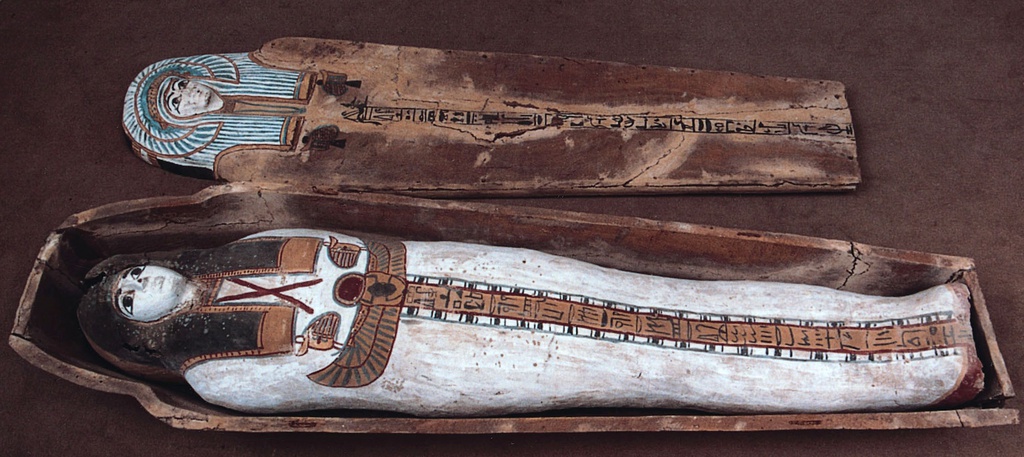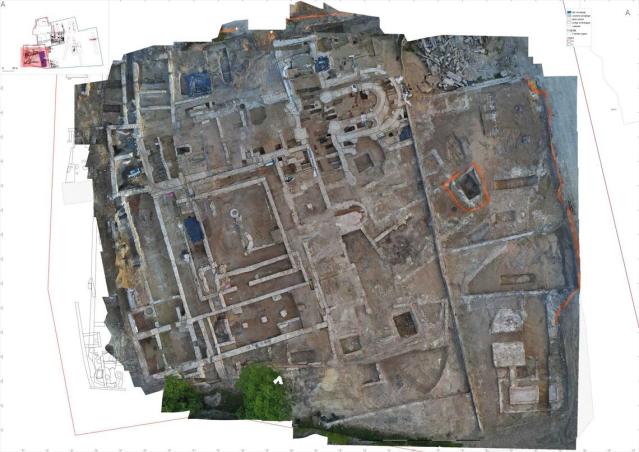Closing in on the archaeological underworld

Switzerland has been cleaning up its free ports after a 1995 scandal on its home turf triggered a probe into looted antiquities. Globally, the fight to disrupt such criminal activity is stepping up with a Web experiment to share information.
Museums the world over still display archaeological treasures that sometimes are not legally theirs. While governments wrangle over their rightful ownership, looters continue to plunder sites to feed a prospering black-market.
Now, an investigative reporter for the Los Angeles Times is trying to set up “WikiLoot”, a way of crowd-sourcing information on looted antiquities via the Web. “We want to make it impossible to turn a blind eye,” Jason Felch told swissinfo.ch.
Felch and Ralph Frammolino led a five-year investigation that culminated in 2011 with their publication of Chasing Aphrodite, an account of the archaeological underworld that reads like a thriller.
The discovery in 1995 that Geneva’s free port was a haven for an international network of looted antiquities linked to the Getty Museum in Los Angeles was the starting point of their investigation.
When the car of a former Italian policeman crashed in August 1995 on a road halfway between Naples and Rome, the unravelling of an enormous smuggling ring was about to begin.

Acting rapidly on the evidence found in the dead man’s car, the Italian Carabinieri approached the Swiss authorities for the joint raid of a room on the fourth floor of the Geneva free port, the base of a company associated with an Italian antiquities dealer, Giacomo Medici.
It was found to contain thousands of objects from plundered tombs, mostly from Italy and, even more importantly, complete documentation on previous transactions, many with the leading museums of the world.
Tougher law
“Medici felt so safe in Geneva, that he kept extensive records and photographs of all the objects,” Felch observed. In 2004, Medici was finally sentenced to ten years (reduced to eight on appeal) by an Italian court and fined €10 million (SFr12 million). Italy is still recovering the artefacts.
In response to the scandal that had blown up in the Geneva vaults, Switzerland finally kicked into action: in 2003, it passed a law to regulate the international transfer of cultural property further to the 1970 Unesco convention on cultural property. In 2005 it set up a bureau to implement the law.
Free ports became subjected to the same regulations that guide all imports, with the obligation to declare ownership, origin and value for all goods imported. Since 2009, a complete inventory is also required.
Benno Widmer, an art historian and lawyer, is head of the Federal Culture Office’s section on the international transfer of cultural property.
He guided swissinfo.ch through the complexity of a structure that on the one hand is part of the Swiss Federal Culture Office, relies on Swiss custom officers to do the verifications at the border, but must also step back when fraud is discovered and a criminal procedure is instigated by the canton in which the free port is located.
The case of an invaluable Roman sarcophagus discovered by Swiss customs officers in December 2010 in Geneva’s free port is revealing. Put on the market by Phoenix Ancient Art, a leading art gallery that specialises in antiquities, there are allegations that it might have been plundered from a site in southern Turkey.
Turkey, as part of a forceful – and successful – international campaign to obtain the repatriation of cultural property that it says it owns, has asked canton Geneva to confiscate the tomb. A cantonal penal procedure has been initiated.
Widmer was therefore not free to comment on the event, although it is known that Bern and Ankara are negotiating a treaty that defines the conditions of repatriation of antiquities illegally exported from Turkey and that could help streamline procedures henceforth.
Hard to prove
When an “off-shore”, “no questions asked” free port was opened in Singapore in 2010, it was feared that stringent Swiss regulations would ward off users of Swiss free ports, but Geneva continues to run at 100 per cent capacity and is expanding.
Felch indicated that because countries like Switzerland usually engage criminal – and not civil – proceedings when wrongdoing is suspected, cases are frequently dismissed on the grounds of technicalities or because the crimes are hard to prove, especially when the origin of the stolen artefacts cannot be identified.
Felch mentioned the standing joke that when an art object is of dubious provenance, it is invariably attributed to “a private Swiss collection”.
He also described the sophisticated Medici scheme to obtain an artefact’s virginity: Medici would clean up the freshly looted object and consign it to an auction in New York or London. He would then place a straw buyer who would acquire the article and return it to him with the “stamp of legitimation”.
“Auction houses acted as laundromats; they were complicit to what was going on.”
Sharing data
By aggregating the wealth of information that is already available, Felch is hoping that people will be encouraged to look for the truth. “WikiLoot will shine a bright light on the black market,” he said.
The extensive criminal investigations that led to Medici and, now, to the no less notorious Sicilian antiquities dealer Gianfranco Becchina have thrown up millions of documents that could be processed by what is commonly referred to as the semantic Web, a way for individuals and institutions to acquire a collective understanding through the sharing and processing of raw data.
WikiLoot has yet to secure proper financing, although potential partners have been identified.
But Paolo Ferri, the Italian prosecutor who awakened his country to the extent of the damage of the looting – and who bulldozered the raid in Geneva – is not convinced by WikiLoot. He is afraid that the publishing of information on objects of dubious origin will push smugglers to adopt new strategies of concealment.
As long as people or institutions feel they have a right to buy and therefore own antiquities, sites will continue to be plundered and illegal commerce will thrive, Felch said.
“Only when we move beyond the concept of ownership for objects of cultural heritage and accept that they cannot be bought, will the black market lose interest,” he suggested.
The 2003 Cultural Property Transfer Act (CPTA) allowed Switzerland to ratify the 1970 Unesco convention on cultural property.
It was followed by an ordinance in 2005 that made the declaration of the origin, ownership and value of cultural property imported into Switzerland obligatory. That followed in 2009 with the obligation for all holders in free ports to make available at all times a complete inventory of goods held.
In 2003, Swiss customs discovered 200 stolen ancient Egyptian treasures, including two mummies, at Geneva’s free port. They were returned to Egypt.
The Art Loss Register operates a permanent international database of stolen and missing works of art, antiques and valuables. It also presents a list of publications that read like cape and dagger novels.
A scholarly team at the University of Glasgow has recently received a £1 million grant over four years from the European Research Council to research the illicit trade in ancient art.
The Turkish culture and tourism minister, Ertugrut Gunay, is leading a highly publicised campaign that promises repercussions if reclaimed treasures are not returned to Turkey.
Gunay is following in the footsteps of Greece (Melina Mercouri’s crusade to obtain the return of the Elgin marbles from the British Museum) and Egypt (former minister of state for antiquities affairs Zahi Hawass’ attempts to obtain the repatriation of Egyptian treasures, including the Rosetta Stone).
In May 2005 an Italian court found Giacomo Medici guilty of illegal export, receiving stolen goods, and conspiracy. Illegally traded Italian artifacts were returned to Italy from museums, namely the New York Metropolitan Museum of Art (21 objects in 2006), the Boston Museum of Fine Arts (13 objects in 2006), the Cleveland Museum of Art (14 objects in 2009), the J. Paul Getty Museum (40 objects in 2007), and the Princeton University Art Museum (8 objects in 2007).
WikiLoot’s author, Jason Felch, deplores the confusion of issues: he does not believe that claims for restitution of cultural property due to historical wrongdoing (during the 19th century and early 20th century) are comparable to the looting of sites that continue to take place today for purely financial benefit. WikiLoot aims to stop the plundering of archeological heritage.
Related Post
A shocking documentary proves that mermaids do exist
SHOCKING Revelation: Thuya, Mother of Queen Tiye, Was the Grandmother of Akhenaten and Tutankhamun—What Ancient Egyptian Secrets Did She Leave Behind?
Breaking News: Astonishing Discoveries at Karahan Tepe Confirm an Extraterrestrial Civilization is Hiding on Earth, and NO ONE Knows!
Breaking News: Researchers FINALLY Discover U.S. Navy Flight 19 After 75 Years Lost in the Bermuda Triangle!
NASA’s Secret Investigation: Uncovering the Astonishing Mystery of the UFO Crash on the Mountain!
Explosive UFO Docs LEAKED: Startling Proof That Aliens Ruled Ancient Egypt!
